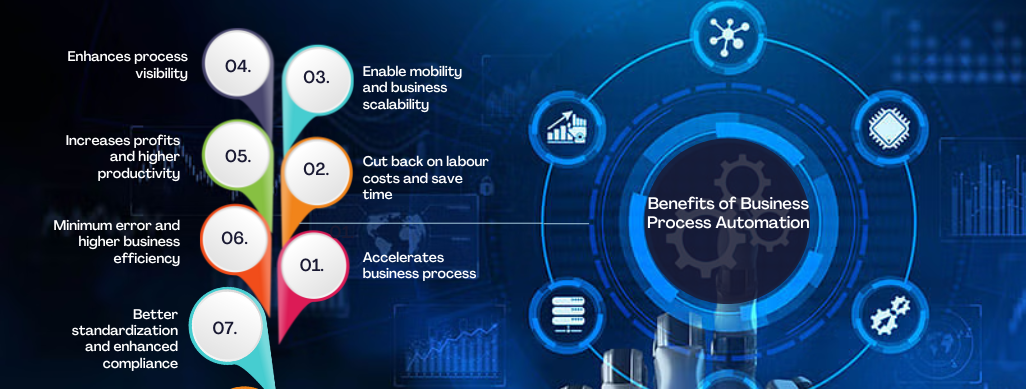
We use cookies to ensure that we give you the best experience on our website.
By using this site, you agree to our use of cookies. Find out more.
This blog delves into the transformative power of BPA, exploring its applications, benefits, and how it can propel your organization towards newfound heights of success and growth.

In today's fast-paced business environment, where agility and efficiency are paramount, organizations are constantly seeking strategies to streamline operations, minimize costs, and gain a competitive edge. Business Process Automation (BPA) has emerged as a game-changing solution, empowering companies to unlock their full potential and maximize efficiency across various facets of their operations. By leveraging cutting-edge technologies and intelligent automation, BPA revolutionizes the way businesses function, enabling them to achieve unprecedented levels of productivity, accuracy, and scalability. This blog delves into the transformative power of BPA, exploring its applications, benefits, and how it can propel your organization towards newfound heights of success and growth.
Business Process Automation (BPA) is a transformative approach that leverages advanced technologies to streamline and optimize business operations. At its core, BPA involves the use of software, algorithms, and intelligent systems to automate repetitive, rule-based tasks and workflows across various business functions. This automation eliminates the need for manual intervention, enabling organizations to operate with unprecedented efficiency, accuracy, and consistency.
BPA encompasses a wide range of technologies, including robotic process automation (RPA), artificial intelligence (AI), machine learning (ML), and business process management (BPM) systems. These powerful tools work in tandem to automate everything from data entry and processing to decision-making and complex analytical tasks. By automating these processes, businesses can significantly reduce operational costs, minimize errors, improve compliance, and enhance overall productivity. Ultimately, BPA empowers organizations to focus their resources on strategic initiatives, innovation, and delivering exceptional value to their customers, driving growth and long-term competitiveness in an increasingly dynamic business landscape.
Here are some key areas where Business Process Automation can be incorporated:
By incorporating Business Process Automation in these areas, organizations can unlock significant benefits, including accelerated processes, cost savings, enhanced mobility and scalability, increased process visibility, higher productivity, minimized errors, and better standardization and compliance.
Here are the key benefits of Business Process Automation:

Business Process Automation acts as a catalyst, propelling organizations towards unprecedented levels of efficiency and agility. By automating repetitive and mundane tasks, companies can significantly accelerate their processes, enabling them to keep pace with the ever-increasing demands of the modern business landscape. Automated workflows eliminate bottlenecks, streamlining operations and reducing turnaround times across various departments and functions. This acceleration not only enhances productivity but also translates into tangible benefits for customers, as their needs are addressed with remarkable speed and precision. Moreover, by freeing up valuable resources from routine tasks, businesses can focus their efforts on strategic initiatives, innovation, and delivering exceptional value to their clients, ultimately driving growth and establishing a competitive edge in their respective markets.
One of the most compelling advantages of Business Process Automation is its ability to substantially reduce labor costs and save precious time. By automating repetitive and mundane tasks, organizations can significantly minimize their reliance on human intervention, thereby optimizing their workforce utilization. Automated processes seamlessly handle high-volume transactions, data entry, and routine operations, allowing employees to redirect their efforts towards more complex and strategic endeavors. This not only enhances productivity but also fosters a more engaged and motivated workforce, as employees are empowered to contribute their skills and expertise to higher-value activities. Furthermore, the time savings achieved through automation translate into faster turnaround times, improved customer experiences, and increased operational agility, enabling businesses to respond swiftly to market demands and seize emerging opportunities, ultimately driving growth and profitability.
In today's rapidly evolving business landscape, agility and scalability are paramount to success. Business Process Automation emerges as a powerful enabler, unleashing unprecedented levels of mobility and scalability for organizations. By automating core processes, businesses can seamlessly adapt to remote work environments, empowering employees to access and manage operations from anywhere, at any time. This mobility fosters a collaborative and flexible workforce, enhancing productivity and enabling businesses to tap into a global talent pool. Moreover, automated processes can effortlessly scale up or down in response to fluctuating demands, eliminating the constraints of manual operations. As businesses grow, automated systems can handle increasing volumes of transactions, data processing, and workflow management without compromising efficiency or accuracy. This scalability ensures that organizations can expand their operations, enter new markets, and seize emerging opportunities with ease, providing a sustainable foundation for long-term growth and competitiveness in an ever-changing business landscape.
Business Process Automation not only streamlines operations but also empowers organizations with enhanced process visibility, a critical advantage in today's data-driven business environment. Automated systems meticulously track and monitor every step of a process, providing real-time insights and comprehensive data that would be challenging to gather through manual means. This increased transparency enables organizations to identify bottlenecks, inefficiencies, and areas for improvement with precision. By gaining a granular understanding of their processes, businesses can make informed decisions, optimize resource allocation, and implement targeted strategies to drive continuous improvement. Furthermore, this heightened visibility fosters accountability and facilitates compliance with industry regulations and standards, minimizing risks and ensuring adherence to best practices. Ultimately, enhanced process visibility serves as a catalyst for organizational growth, enabling data-driven decision-making, proactive problem-solving, and the cultivation of a culture of continuous improvement.
Business Process Automation has emerged as a game-changer, enabling organizations to unlock unprecedented levels of profitability and productivity. By streamlining and optimizing processes, businesses can achieve significant cost savings, as automated systems eliminate the need for manual intervention in repetitive tasks. This reduction in labor costs, coupled with increased operational efficiency, directly translates into higher profit margins and a competitive edge in the market. Moreover, automated processes inherently facilitate higher productivity across all aspects of an organization. Employees are freed from mundane tasks, allowing them to focus their efforts on more strategic and value-added activities. Automated workflows eliminate bottlenecks, ensuring seamless and uninterrupted operations, maximizing output and throughput. This increased productivity not only drives business growth but also enhances customer satisfaction by delivering products and services with remarkable speed and quality. Ultimately, the synergy between cost savings and enhanced productivity positions businesses to thrive in an increasingly competitive landscape, unlocking new avenues for innovation, expansion, and long-term sustainability.
Business Process Automation plays a pivotal role in minimizing errors and driving higher business efficiency, two critical factors that can make or break an organization's success. By eliminating the risk of human error inherent in manual processes, automated systems ensure consistency, accuracy, and adherence to predefined rules and protocols. This precision not only enhances operational efficiency but also minimizes costly mistakes, rework, and compliance issues, enabling businesses to maintain a competitive edge.
Moreover, automated processes are designed to optimize resource utilization, streamline workflows, and eliminate redundancies, thereby maximizing efficiency across all aspects of an organization. From inventory management to customer service, automated systems facilitate seamless integration and coordination, fostering a cohesive and synchronized operation. This heightened efficiency translates into faster turnaround times, improved productivity, and enhanced customer experiences, ultimately driving business growth and profitability. By embracing Business Process Automation, companies can navigate the complexities of today's business landscape with confidence, leveraging the power of error-free operations and unparalleled efficiency.
Business Process Automation plays a crucial role in fostering better standardization and enhancing compliance within organizations. By automating processes according to predefined rules, protocols, and best practices, businesses can ensure consistent operations across all departments and locations. This standardization eliminates variations and inconsistencies that often arise from manual processes, promoting uniformity and coherence throughout the organization. Moreover, automated systems are designed to adhere to industry regulations, legal requirements, and internal policies, minimizing the risk of non-compliance and potential penalties. Real-time monitoring and reporting capabilities enable organizations to track and verify compliance, providing peace of mind and mitigating legal and reputational risks. This enhanced compliance not only safeguards businesses from potential liabilities but also instills confidence in customers, partners, and stakeholders, strengthening relationships and facilitating long-term success. By embracing Business Process Automation, companies can establish a strong foundation of standardization and compliance, positioning themselves as reliable and trustworthy players in their respective industries.
In the ever-evolving business landscape, embracing Business Process Automation is no longer an option but a necessity for organizations seeking to thrive and stay ahead of the competition. By automating repetitive tasks, streamlining workflows, and optimizing resource utilization, businesses can unlock a wealth of benefits, including increased profitability, enhanced productivity, and improved customer experiences. Moreover, BPA fosters a culture of continuous improvement, enabling organizations to adapt swiftly to changing market dynamics and seize emerging opportunities with agility. As businesses navigate the complexities of the modern era, BPA emerges as a powerful ally, empowering them to break free from the constraints of manual processes and unleash their true potential. By embracing this transformative technology, companies can pave the way for sustainable growth, innovation, and long-term success in an increasingly competitive and demanding business environment.
Leave a Comment
Your email address will not be published.